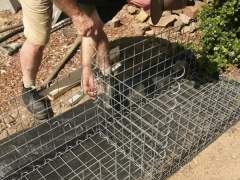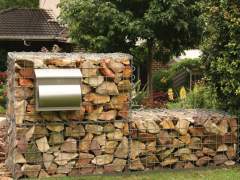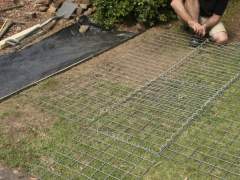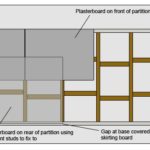How to build a gabion wall for your garden with your own hands. After learning this information you will build a most beautiful wall.
Gabion wall design is rather popular in the modern landscape construction. These designs are easy to make with your own hands, if you want to build a fence protecting the area from noise. Gabions are used as retaining walls, reinforcing for the banks of ponds, creating architectural decorations. This beautiful unusual structures don’t violate the ecosystem of the site and don’t interfere with the development of vegetation. If the question how to build a gabion wall is now actual for you, this article contains the necessary information.
What is a gabion?
“Gabion” is translated from French as “a large cell”. It is a frame or a box made of the mesh that is filled with pebbles, rocks or gravel.
Gabion walls features
 The main features of gabion walls are:
The main features of gabion walls are:
- regulation of riverbeds and embankments organization;
- creation of wall-backwater and protection of slopes from the possibility of landslides;
- strengthening the shores of ponds;
- protecting soils from erosion and landslides;
- creation of fences and hedges in the suburban areas;
- protection of the territory from the wind;
- decorative arrangement of suburban areas.
Due to their high strength gabions can carry substantial loads (ice, erosion, soil mass). Each gabion firmly adheres to the neighboring one due to the galvanized wire. The gabions are not destroyed, even absorbing the different soil settlement. Even during the powerful erosions at the base of the construction gabion structures are only slightly deformed without losing its strength. Over the time the gabions are transformed into an element of the natural landscape as they accumulate in the soil particles themselves and become even stronger.
 The only disadvantage of such structures is a metal mesh, but after some time it will not be seen because the design will be overgrown with greenery. Most often the slopes and coast are reinforced with concrete products. But mounting gabions doesn’t require heavy construction equipment, as opposed to the construction of concrete structures. They also don’t need creating of a drainage system. The cost of gabions structures is 15% lower than the one of concrete structures as well.
The only disadvantage of such structures is a metal mesh, but after some time it will not be seen because the design will be overgrown with greenery. Most often the slopes and coast are reinforced with concrete products. But mounting gabions doesn’t require heavy construction equipment, as opposed to the construction of concrete structures. They also don’t need creating of a drainage system. The cost of gabions structures is 15% lower than the one of concrete structures as well.
Types of gabion walls:
- cylindrical gabion walls,
- boxed gabion walls,
- rectangular gabion walls divided into sections.
Cylindrical gabion walls
Cylindrical gabions create underwater foundations structures made of gabions box.
Box-shaped gabion walls
Suitable for creating a cumbersome facilities: bank stabilization, construction of retaining walls. Their front side is smooth and has a stepped surface. These gabions must have a height of not more than 25 feet.
Rectangular gabions
They are used for coatings that protect against different types of erosion, they also may be the basis of the device of box-type gabions.
Preparation
 Before the construction of gabion structure you need to find a place for its location. Then carefully prepare the base, tamping the soil. It can be the foundation of a cushion consisting of gravel and sand. You will need a high-quality metal mesh for your future gabion retaining wall. You can choose galvanized stainless mesh or a PVC-coated mesh. At the same time, the load on the mesh must be properly calculated, or the design will fall in future. Colors and sizes of stone depends on your own ideas and imagination and the look of the landscape of your site. The value corresponds to the size of stones mesh. The fraction of rubble is usually 3-5 inches. The selected stones have to have a high density, durability and frost-resistance, especially if the structures which will be interacting with water are being built.
Before the construction of gabion structure you need to find a place for its location. Then carefully prepare the base, tamping the soil. It can be the foundation of a cushion consisting of gravel and sand. You will need a high-quality metal mesh for your future gabion retaining wall. You can choose galvanized stainless mesh or a PVC-coated mesh. At the same time, the load on the mesh must be properly calculated, or the design will fall in future. Colors and sizes of stone depends on your own ideas and imagination and the look of the landscape of your site. The value corresponds to the size of stones mesh. The fraction of rubble is usually 3-5 inches. The selected stones have to have a high density, durability and frost-resistance, especially if the structures which will be interacting with water are being built.
The most common stone material for gabions are the following:
- quartzite;
- diorite;
- basalt;
- granite.
Sandstone and other stones with high frost resistance and high strength are also popular for these designs.
The installation guide
- Preparing the frame.
 The mesh should be cut out and sewn, giving it the desired shape. For this purpose use weld or a solid wire. For the long gabion walls barriers should be provided. This structure is usually filled gradually – from one section to another.
The mesh should be cut out and sewn, giving it the desired shape. For this purpose use weld or a solid wire. For the long gabion walls barriers should be provided. This structure is usually filled gradually – from one section to another.
- Setting the frame.
- Laying of stones
The construction is filled with stones after the installation at the desired location and the adhesion to adjacent gabions. If you selected solid bricks, stones and flat pebbles, they should be laid out manually. Small pebbles of different forms are laid compacting each layer. If the container mesh is above 2 feet, the first stack of stones should be 1/3 the needed height. Then the rear wall is connected with the front struts with special ties or a wire. Then it is filled with stones at 2/3 the needed height and so on. Flat gabions need to be filled immediately. If gabions are stacked in multiple layers, the bottom is filled with stones of 2 inches above the container with regard to their shrinkage. The construction is more stable if it is fixed by transverse inner bars at a distance of about 2 feet from each other.
We hope this article helped you in case you were searching an answer to the question how to build a gabion wall with your own hands.



